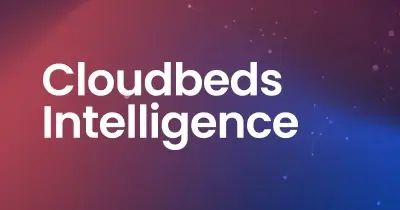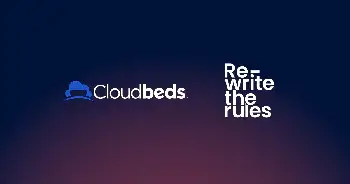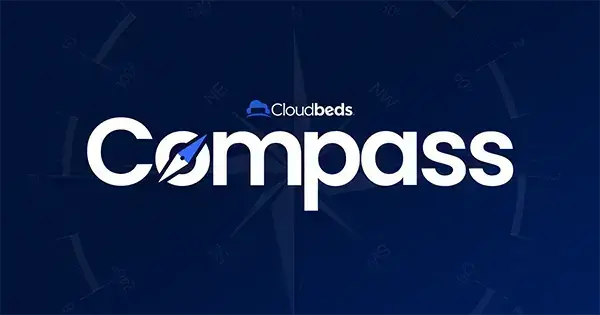
By Cloudbeds
When planning a trip, travelers browse dozens of properties across multiple websites before landing on their final pick.
While you want them to choose your hotel (and ideally book through your website), you should also aim to maximize the performance of your booking channels to generate more revenue at lower acquisition costs. That’s the essence of a hotel distribution strategy.
In this article, we explore how hotels can build a distribution strategy that attracts the right audience at the right price and time.
A hotel distribution strategy involves selecting and managing the different channels through which a hotel sells its rooms to potential guests. A basic strategy might involve listing your property on a few key online travel agencies (OTAs) like Airbnb and Booking.com and leaving it at that. The most successful strategies, however, are more complex and require a mix of channels and considerations. By strategically analyzing revenue booked, occupancy rates, acquisition costs, and guest segments, hotels can build an advanced distribution strategy that delivers real value. What is a hotel distribution strategy?
Distribution KPIs
How do you know if your distribution strategy is really working? Several key performance indicators or KPIs must be tracked simultaneously to determine the effectiveness of your strategy. These include:
- Occupancy rate – which channels contribute most to occupancy?
- RevPAR – which booking sites result in the highest RevPAR?
- Booking volume – which channels bring the most reservations?
- Cost of acquisition – which channels are most cost-effective?
- Guest satisfaction – are certain channels bringing more suitable guests?
It’s important to dig into the data and examine the source of your bookings. A specific OTA may help increase occupancy, but it might not actually be profitable for your hotel.
Alternative channels may attract a better guest segment that spends more and has higher satisfaction levels but results in lower occupancy rates.
Ultimately it’s about understanding what channels increase profitability at your hotel.
13 hotel distribution strategies
Hotel distribution channels can be direct or indirect. Direct channels allow travelers to make a reservation directly with the property through the hotel’s website, social media channels, walk-ins, phone, and email.
Indirect channels, such as OTAs, metasearch sites, Global Distribution Systems (GDS) such as Amadeus and Sabre, travel agents, tour operators, and wholesalers, are third-party platforms that serve as intermediaries by listing hotel rooms.
Hotel management must balance direct and indirect channels to secure a steady stream of bookings whilst increasing revenue.
Direct channel strategies
Direct bookings are gold as they help hoteliers avoid hefty commissions and fees and ensure ownership of guest data, but that doesn’t mean there isn’t a price attached. Here we break down strategies to maximize ROI on direct channels.
1. Retargeting advertisements
When visitors leave your website without making a reservation, you can use ad retargeting to display your property’s brand ad as they continue browsing. This way, you stay top-of-mind of travelers who are actively planning their trip and have already shown interest in your property. Ad retargeting tools also allow you to create ads with AI-generated content and set your own investment budget to streamline hotel marketing efforts.
2. Offline networking
While online marketing is essential, you shouldn’t discount the power of offline networking to learn about how other hoteliers in the hospitality industry are operating, make your hotel brand known, and attract more group business. There are numerous strategies to explore: connect with local community groups, form partnerships with businesses, or join hospitality associations.
3. Website personalization
Personalizing website content can significantly increase conversions compared to showing the same site to everyone. For example, you can use Google Analytics 4 (GA4) to create different landing pages or pop-up banners depending on visitor location, referring source, or search term used to land on your website. With tools from our partner, The Hotels Network, for example, you can take it a step further and personalize single elements of the page for a specific target audience.
4. Dedicated groups & events page
A simple way to secure more group business is to add a groups & events page to your website, where you can outline your USP and explain why you’re a great fit for certain groups. A dedicated page also allows you to outline your group sales and booking process, demonstrating that you understand the needs of the market and are committed to creating an exceptional guest experience.
With technology, you can integrate forms into your website that flow directly into your property management system (PMS) and event management software to streamline this process and make online booking easier for groups.
5. Chatbots
Generative AI-based chatbots on hotel websites can engage with visitors in multiple languages, identifying purchase intent and making personalized offers. When integrated with the hotel’s booking engine, these chatbots effectively become virtual sales representatives that provide real-time information on room availability, rates, and upsells and even allow visitors to complete their booking directly through the chat window.
6. Integrated payment system
The days of cash payments and taking cards over the phone are gone in the hotel industry. Modern guests, especially younger ones, expect secure online payment options, while a poor payment experience can lead to abandoned bookings.
Adding to that, with the proliferation of hotel booking channels, independent hotels are now managing different payment methods, policies, and processes simultaneously. An integrated system that connects credit card details to reservations in the PMS is essential for managing this complexity and creating a better booking experience for guests.
Another piece of advice? Consider offering payment methods like buy now, pay later (BNPL). Leading BNPL provider Affirm reported that travel providers using BNPL see a +48% increase in average booking value as it affords travelers the time to plan their dream getaway and splurge on luxury add-ons.
7. Voice channel
Thought the voice channel was dead? Think again. Many guests still prefer the convenience of calling hotels to ask questions and book – and it can be a lucrative outlet for hotels. Revinate’s 2024 Hospitality Benchmark Report found that the voice channel generates the highest average booking value of any channel.
Revinate advises that hotels optimize their voice channel by investing in training, call scripts, and rich guest profiles to personalize the experience and increase conversions.
8. Data analytics
Your hotel applications are a goldmine of information you can use to maximize your distribution channels. Tools like your channel manager, booking engine, and PMS can reveal valuable insights into guests’ preferences or which channels have the highest paying customer base, lowest cancellation rates, or lowest fees.
Using a hospitality-focused business intelligence system will help you make sense of metrics coming from different sources to determine how and when to leverage indirect channels and tailor marketing strategies.
Indirect channel strategies
Indirect channels are more challenging to control but often bring in a more reliable and steady stream of bookings and are therefore an important component of a hotel’s distribution strategy.
9. Strategic use of OTAs
An effective way to reduce commissions paid to OTAs and metasearch engines is to rely on them more during off-peak and shoulder seasons, while limiting inventory during peak season, when you receive more direct bookings. The analysis of historical data on direct versus indirect bookings will help you finetune your strategy for maximum hotel revenue.
10. Metasearch ads
Metasearch engines like Trivago, Kayak, and Google Hotel Ads give you the opportunity to list your hotel alongside online travel agents. They’re mainly based on a pay-per-click (PPC) model where the ranking on search engine results will also depend on how much you’re willing to bid per click.
Instead of trying to outbid large OTAs, focus on finding the right balance. Ensure your average daily rate (ADR) covers ad spend while leaving a profit margin but invest enough to capture user attention.
11. Smaller niche OTAs
Booking.com and Expedia are not the only options when it comes to OTAs. You can cast a wider net with other niche OTAs that cater to specific types of travelers and experiences if they align with your target guests.
For example, Stayforlong.com for stays of at least three nights, BringFido for pet-friendly accommodations, and Tripaneer for experiences such as spiritual retreats, cycling weekends, or even martial arts camps. Niche OTAs are perfect if you’ve identified the markets that work best for your business, as guests are usually willing to pay more if they’re guaranteed a certain experience.
Another benefit of being present on more OTAs is the billboard effect, when potential guests discover your hotel on a third-party channel and then visit your website to book directly.
12. Reputation management
While guests may complete their booking on your website, their initial search often starts on platforms like Google, Booking.com, or Tripadvisor. Reviews on these sites are where potential guests form their first impression about properties, so ignoring negative feedback can quickly result in being dropped from their shortlist. Using reputation management software allows you to actively monitor and enhance your online reviews and generate more bookings.
13. Destination marketing organizations
Listing your property with local, regional, or national destination marketing organizations (DMOs) can be a valuable strategy. Pure Michigan, for example, maintains a directory with more than 1,000 hotels, while New Orleans’ DMO will even assist event planners in contacting hotels for group accommodations. Although additional services may come with a fee, being added to hotel listings is typically free of charge.
The role of technology in effective distribution
The more channels you’re active on, the more complex it becomes to manage. That’s where technology can help. Not only can technology help you ensure rates and availability remain up to date, but it can provide invaluable data and insights to analyze the effectiveness of your distribution strategy.
Here’s how different hotel tech can help support distribution.
PMS
Your PMS is the core of your distribution strategy, where all reservation data is stored. By integrating your PMS with other systems in your tech stack, you can turn it into a single source of truth for all the data needed to plan and optimize.
Booking engine
Your booking engine helps manage the end-to-end booking experience on direct channels including your website, from the look and feel of the listings page to the payment process and rate monitoring.
To increase conversions, you should be able to customize your booking engine and have deep integration with the PMS to facilitate a seamless guest experience, from instant confirmation emails to proper room assignments and easy payments.
Channel manager
Your channel manager maintains and updates connections with all your indirect channels, allowing you to execute and adjust your distribution strategy on OTAs, GDSs, and metasearch engines in real-time, ensuring that rates and availability are always up to date.
Central reservation system (CRS)
Your CRS is the chief supervisor of your distribution strategy. It confirms or denies each reservation request and updates all channels with new availability and rates. As soon as rooms become available, the CRS makes them visible and bookable by travelers and travel agents on all distribution channels.
Customer relationship management (CRM) system
Your CRM is the primary source for aggregated information on guests, such as reservation behavior, preferences, and spending patterns. This data helps understand preferences, segment audiences, and craft personalized marketing campaigns that lead to higher conversion rates.
Revenue management system (RMS)
Whether you are bound to maintain rate parity or you’re allowed to offer lower rates on your direct channels, the RMS will help you optimize rates dynamically based on demand, competitors’ rates, time of booking, occupancy rates, etc. and push those suggestions to your PMS, channel manager, and booking engine to be updated in real time.
Business intelligence system
A BI solution extracts valuable insights from multiple data sources. For distribution, it can reveal booking patterns, identify customer segments based on demographics and preferences, and determine which channels drive the best bookings.
AI: Bringing everything together
Cloudbeds Intelligence, an AI and machine learning layer built into the Cloudbeds platform, was built to help hoteliers bring together different components of distribution, including revenue management and marketing, to help hotels boost total revenue and profitability.
Coming in 2025, Cloudbeds Intelligence will provide hotels with past and forward-looking demand signals and intelligent recommendations for optimized campaigns. For example, it will automatically create target segments for direct marketing campaigns and suggest what pricing and upsells to push out and at what time.
Finding the right strategy
Distribution is not one size fits all – it requires constant iteration to find the strategy that works best for your business. While it can be tempting to rely on channels that bring quick wins, examining your data to find the channels and strategies that deliver the best guests and overall revenue will pay off in the long run.

















